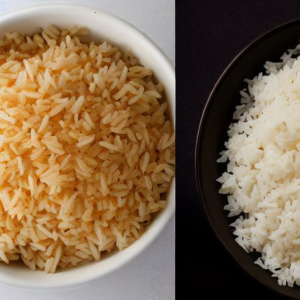When it comes to healthy eating and managing blood sugar levels, understanding the glycemic index (GI) of various foods is crucial. The GI is a measurement that indicates how quickly carbohydrates in a particular food raise blood sugar levels. We’re going help you understand the glycemic index of brown rice, highlight its nutritional benefits and comparing it with 10 other rice varieties, including white rice. We will also explore how cooking methods can impact the GI score of rice.
 The Glycemic Index of Brown Rice: Brown rice is a highly nutritious whole grain that has gained popularity for its numerous health benefits. The GI of brown rice is considered moderate, ranging from 50 to 69, depending on factors such as the variety, processing, and cooking method. The moderate GI score of brown rice can be attributed to its fiber content, bran layer, and slower digestion process compared to white rice.
The Glycemic Index of Brown Rice: Brown rice is a highly nutritious whole grain that has gained popularity for its numerous health benefits. The GI of brown rice is considered moderate, ranging from 50 to 69, depending on factors such as the variety, processing, and cooking method. The moderate GI score of brown rice can be attributed to its fiber content, bran layer, and slower digestion process compared to white rice.
Comparative Analysis: Brown Rice vs. 10 Other Rice Varieties: To understand the GI of brown rice better, let’s compare it with 10 other rice varieties, including white rice. The GI scores mentioned below are approximate values and may vary slightly depending on different sources:
| Rice Variety | Glycemic Index (GI) Score |
|---|---|
| Brown Rice | 50-69 |
| White Rice | 70-73 |
| Basmati Rice | 50-58 |
| Jasmine Rice | 68-80 |
| Arborio Rice | 69-75 |
| Wild Rice | 57-87 |
| Black Rice | 42-57 |
| Red Rice | 55-65 |
| Camargue Rice | 51-56 |
| Sushi Rice | 70-73 |
| Sticky Rice (Glutinous Rice) | 85-95 |
Cooking Methods and Impact on GI Score: The way rice is cooked can significantly affect its GI score. Generally, overcooking rice or cooking it to a very soft texture can increase the GI score as the starch becomes more accessible for digestion. On the other hand, cooking rice al dente or slightly firm can help maintain a lower GI score as it slows down the digestion process.
Boiling, steaming, or using a rice cooker are preferred cooking methods for maintaining a lower GI score. Adding a splash of vinegar or consuming rice with other high-fiber foods, vegetables, or lean proteins can also help slow down the digestion process, resulting in a lower glycemic response.
Glycemic Index of Brown Rice
Understanding the glycemic index of rice is essential for making informed dietary choices, particularly for individuals concerned about blood sugar levels. Brown rice, with its moderate GI score, stands out as a nutritious option, providing fiber, essential minerals, and vitamins. While white rice typically has a higher GI score, opting for cooking methods that maintain a firmer texture can help mitigate its impact. By considering the GI scores and choosing suitable cooking methods, individuals can make rice a part of a balanced diet without experiencing drastic spikes in blood sugar levels.
Remember, it’s always advisable to consult with a healthcare professional or registered dietitian for personalized dietary advice based on your specific needs and health conditions.
